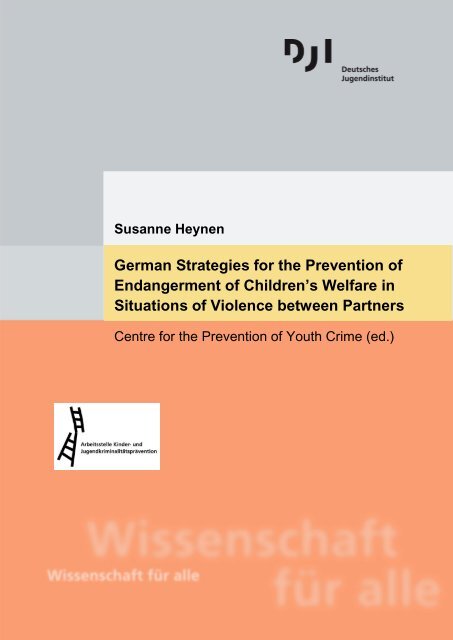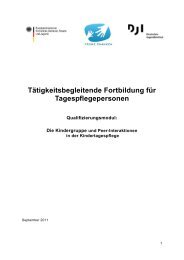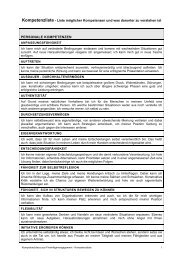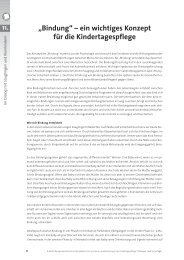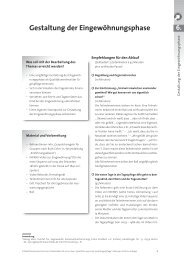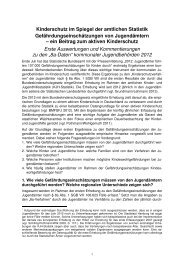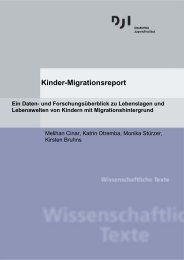German Strategies for the Prevention of Endangerment of Children's ...
German Strategies for the Prevention of Endangerment of Children's ...
German Strategies for the Prevention of Endangerment of Children's ...
You also want an ePaper? Increase the reach of your titles
YUMPU automatically turns print PDFs into web optimized ePapers that Google loves.
Susanne Heynen<br />
<strong>German</strong> <strong>Strategies</strong> <strong>for</strong> <strong>the</strong> <strong>Prevention</strong> <strong>of</strong><br />
<strong>Endangerment</strong> <strong>of</strong> Children’s Welfare in<br />
Situations <strong>of</strong> Violence between Partners<br />
Centre <strong>for</strong> <strong>the</strong> <strong>Prevention</strong> <strong>of</strong> Youth Crime (ed.)
Centre <strong>for</strong> <strong>the</strong> <strong>Prevention</strong> <strong>of</strong> Youth Crime (ed.)<br />
Susanne Heynen<br />
<strong>German</strong> <strong>Strategies</strong> <strong>for</strong> <strong>the</strong> <strong>Prevention</strong> <strong>of</strong><br />
<strong>Endangerment</strong> <strong>of</strong> Children’s Welfare<br />
in Situations <strong>of</strong> Violence between Partners
The Author:<br />
Dr. Susanne Heynen<br />
Kinderbüro, City <strong>of</strong> Karlsruhe, <strong>German</strong>y<br />
The Centre <strong>for</strong> <strong>the</strong> <strong>Prevention</strong> <strong>of</strong> Youth Crime is subsidised by <strong>the</strong> Federal Ministry<br />
<strong>of</strong> Familiy Affairs, Senior Citizens, Women and Youth:<br />
This text is an excerpt <strong>of</strong> <strong>the</strong> volume “Strategien der Gewaltprävention im Kindes-<br />
und Jugendalter” (National Report on <strong>Strategies</strong> <strong>for</strong> Violence <strong>Prevention</strong> in Child<br />
and Youth Age Groups in <strong>German</strong>y) published in 2007 by <strong>the</strong> <strong>German</strong> Youth Institute.<br />
The <strong>German</strong> report can be ordered free <strong>of</strong> charge by email, please contact:<br />
jugendkriminalitaet@dji.de<br />
© 2009 by Deutsches Jugendinstitut e.V.<br />
Arbeitsstelle Kinder- und Jugendkriminalitätsprävention -<br />
Centre <strong>for</strong> <strong>the</strong> <strong>Prevention</strong> <strong>of</strong> Youth Crime<br />
Email: jugendkriminalitaet@dji.de<br />
This text and fur<strong>the</strong>r excerpts <strong>of</strong> <strong>the</strong> National Report on <strong>Strategies</strong> <strong>for</strong> Violence<br />
<strong>Prevention</strong> are available <strong>for</strong> download on <strong>the</strong> website <strong>of</strong> <strong>the</strong> Centre <strong>for</strong> <strong>the</strong> <strong>Prevention</strong><br />
<strong>of</strong> Youth Crime: www.dji.de/youthcrime<br />
Translation by Textworks Translations
Contents<br />
Introduction 7<br />
1 Violence between partners: prevalence and <strong>for</strong>ms<br />
taken 7<br />
2 Special features <strong>of</strong> this field and <strong>the</strong> legislative<br />
context 9<br />
3 <strong>Prevention</strong> strategies 10<br />
3.1 Non-specific prevention strategies <strong>for</strong> inter-partner<br />
violence 11<br />
3.2 <strong>Prevention</strong> strategies targeting specific groups 12<br />
3.3 <strong>Strategies</strong> based on cooperation and networking 14<br />
4 Future prospects and challenges 15<br />
Literature 18
Preventing endangerment <strong>of</strong> children’s welfare in situations <strong>of</strong> violence between partners<br />
Introduction<br />
Many girls and boys experience violence within <strong>the</strong> family. This includes not<br />
only physical and sexually motivated violence directed against <strong>the</strong>m, but also<br />
domestic violence, usually on <strong>the</strong> fa<strong>the</strong>r’s part and directed against <strong>the</strong> mo<strong>the</strong>r.<br />
Only in recent years has it been realised that children and young people are<br />
exposed to a wide range <strong>of</strong> stress factors associated with domestic and interpartner<br />
violence.<br />
In spite <strong>of</strong> statutory provisions such as <strong>the</strong> Platzverweis (exclusion order) and<br />
Gewaltschutzgesetz (Protection from Violence Act), it continues to be necessary<br />
<strong>for</strong> some <strong>of</strong> <strong>the</strong>se children and young people to escape with <strong>the</strong>ir mo<strong>the</strong>rs to<br />
<strong>the</strong> homes <strong>of</strong> relatives or a women’s refuge, consequently changing to a new<br />
nursery or school. For o<strong>the</strong>rs, escape from <strong>the</strong> family situation means quitting<br />
<strong>the</strong> family <strong>the</strong>mselves. Even when <strong>the</strong> family situation has outwardly become<br />
less tense, some children are still – perhaps as a result <strong>of</strong> long-running disputes<br />
over contact and caring rights – confronted with violence during <strong>the</strong> fa<strong>the</strong>r’s<br />
access periods, in nightmares, or in suddenly returning memories. They suffer<br />
from fear, disruption <strong>of</strong> sleep and <strong>of</strong> concentration, or have learnt that violence<br />
is a means <strong>of</strong> getting one’s own way.<br />
Avoidance <strong>of</strong> domestic violence is very important <strong>for</strong> two reasons: first, in<br />
order to protect girls and boys from imposed stresses and from development<br />
impairment; and second, to avert <strong>the</strong> reproduction <strong>of</strong> violence suffered in <strong>the</strong><br />
<strong>for</strong>m <strong>of</strong> violence perpetrated, whe<strong>the</strong>r directed against <strong>the</strong> self, against age<br />
peers, or against a partner later in life.<br />
1 Violence between partners: prevalence and<br />
<strong>for</strong>ms taken<br />
A present-day prevalence study concludes that one woman in four experiences<br />
physical and/or sexual violence at <strong>the</strong> hands <strong>of</strong> her partner 1 . Of <strong>the</strong>se women,<br />
31% had experienced one act <strong>of</strong> violence, 36% reported two to ten situations,<br />
and 33% named ten to 40 situations involving violence. For 64% <strong>of</strong> those affected,<br />
<strong>the</strong> violence resulted in injury. Police criminal records and data collected<br />
in <strong>the</strong> context <strong>of</strong> <strong>the</strong> so-called Platzverweis likewise illustrate <strong>the</strong> stresses to<br />
which women are subjected by violence on <strong>the</strong> part <strong>of</strong> husband or partner,<br />
both during <strong>the</strong> relationship and during and after <strong>the</strong> separation process 2 . A<br />
number <strong>of</strong> different studies indicate that about 25% <strong>of</strong> men state that <strong>the</strong>y<br />
1 cf. BMFSFJ 2004<br />
2 cf. Steffen 2005<br />
Centre <strong>for</strong> <strong>the</strong> <strong>Prevention</strong> <strong>of</strong> Youth Crime (ed.) 7<br />
www.dji.de/youthcrime
Susanne Heynen<br />
have suffered violence at <strong>the</strong> hands <strong>of</strong> a female partner. However, <strong>the</strong> violence<br />
in question was much more frequently a case <strong>of</strong> minor acts <strong>of</strong> violence, which<br />
seldom cause injury. Moreover, scarcely any men report feeling afraid <strong>of</strong> <strong>the</strong>ir<br />
(female) partner.<br />
Johnson (2005; cf. also Johnson/Leone 2005) distinguishes on <strong>the</strong> basis <strong>of</strong><br />
North American prevalence studies between “situational couple violence” – a<br />
frequently occurring and largely non-gender-linked violence pattern associated<br />
with conflicts, which usually involves only minor stresses <strong>for</strong> those affected –<br />
and “intimate terrorism”. Often, though not always, this latter pattern <strong>of</strong> violence<br />
<strong>for</strong>ms part <strong>of</strong> an escalating spiral <strong>of</strong> violence; it leads in most cases to<br />
substantial adverse consequences in various areas <strong>of</strong> life, and it is predominantly<br />
practised by men 3 . The meaning <strong>of</strong> <strong>the</strong> term “intimate terrorism” overlaps<br />
substantially with that <strong>of</strong> “domestic violence”. With reference to <strong>German</strong>y,<br />
Helfferich and Kavemann (2004) show from <strong>the</strong> woman’s perspective <strong>the</strong> great<br />
diversity <strong>of</strong> <strong>for</strong>ms in which violence is encountered, <strong>the</strong> equally great diversity<br />
<strong>of</strong> women’s reactions to violence, and <strong>the</strong> need <strong>for</strong> a corresponding degree <strong>of</strong><br />
diversification in support provision.<br />
Children living in <strong>the</strong> couple’s household are affected, primarily in <strong>the</strong> sense <strong>of</strong><br />
Johnson’s “intimate terrorism’, by violence amounting to systematic controlling<br />
behaviour in <strong>the</strong> context <strong>of</strong> an abusive relationship. Domestic violence<br />
impacts both directly and indirectly on <strong>the</strong> couple’s sons and daughters, and<br />
<strong>of</strong>ten occurs alongside direct acts <strong>of</strong> violence against <strong>the</strong> child. In a study conducted<br />
by <strong>the</strong> Lower Saxony Institute <strong>for</strong> Criminological Research, 21.3% <strong>of</strong><br />
16- to 29-year-olds surveyed (N=1067) stated that <strong>the</strong>y had been confronted<br />
with parental inter-partner violence 4 . 3.7% had been present when one parent<br />
injured <strong>the</strong> o<strong>the</strong>r, using a weapon 5 . Those who repeatedly witnessed violence<br />
were abused eight times more frequently by <strong>the</strong>ir fa<strong>the</strong>rs and mo<strong>the</strong>rs than<br />
those who grew up without parental inter-partner violence. The risk <strong>of</strong> sexual<br />
abuse also increases 6 .<br />
The direct effects <strong>of</strong> domestic violence on children include conception in <strong>the</strong><br />
course <strong>of</strong> rape 7 , pregnancy complications and miscarriage caused by abuse during<br />
pregnancy 8 , and injuries resulting from blows aimed at <strong>the</strong> mo<strong>the</strong>r when<br />
children are close by. A special danger to children lies in <strong>the</strong> eventuality <strong>of</strong> an<br />
escalation <strong>of</strong> violence, up to and including actual killings, when separation<br />
takes place or is intended. The children <strong>the</strong>mselves may be injured or killed;<br />
3 cf. Johnson 1995; Piispa et al., 2002<br />
4 cf. Wetzels 1997<br />
5 cf. Pfeiffer/Wetzels 1997<br />
6 cf. Hammer 1989; Farmer/Owen 1995; cited in Kavemann 2000 and Kindler 2003<br />
7 cf. Heynen 2003<br />
8 cf. Campbell, Garcia-Moreno/Sharps 2004<br />
8 Centre <strong>for</strong> <strong>the</strong> <strong>Prevention</strong> <strong>of</strong> Youth Crime (ed.)<br />
www.dji.de/youthcrime
Preventing endangerment <strong>of</strong> children’s welfare in situations <strong>of</strong> violence between partners<br />
<strong>the</strong>y may lose <strong>the</strong>ir mo<strong>the</strong>r or both parents 9 . Indirect consequences arise from<br />
growing up in an atmosphere <strong>of</strong> violence and inflicted humiliation, which may<br />
also involve neglect, overburdening, and social disadvantage 10 .<br />
Repeated witnessing <strong>of</strong> serious violence – particularly in conjunction with violence<br />
suffered personally – results in substantial age-dependent harm to <strong>the</strong><br />
physical, emotional, cognitive and social development <strong>of</strong> children affected.<br />
Stress-inducing factors such as alcohol dependency or mental illness in a parent,<br />
and risk factors such as poverty and cramped living conditions, increase<br />
<strong>the</strong> likelihood <strong>of</strong> fur<strong>the</strong>r problems 11 . These in turn may give rise to conflicts at<br />
day-care centres and at school 12 . Studies – by <strong>the</strong> Institute <strong>for</strong> Criminological<br />
Research, <strong>for</strong> example, also <strong>the</strong> Hallenser Gewaltstudie (Halle Study <strong>of</strong> Violence)<br />
– have shown that domestic violence may constitute <strong>the</strong> background to violence<br />
and <strong>of</strong>fending, particularly among boys 13 . There is a strong link between<br />
<strong>the</strong> witnessing <strong>of</strong> inter-parental violence and later active commission <strong>of</strong> violent<br />
acts in pair relationships where <strong>the</strong> violence is a component in systematic controlling<br />
behaviour.<br />
2 Special features <strong>of</strong> this field and <strong>the</strong><br />
legislative context<br />
The problems posed by intra-familial violence both to <strong>the</strong> immediate social<br />
environment and to institutions such as counselling centres, youth <strong>of</strong>fices and<br />
<strong>the</strong> police service are <strong>of</strong> a special nature in that <strong>the</strong> violence occurs within <strong>the</strong><br />
private domain ra<strong>the</strong>r than in public. This applies with particular <strong>for</strong>ce to interventions<br />
prompted by violence between partners: <strong>the</strong> concern here is to<br />
mould not only parent-child relationships, but <strong>the</strong> parents’ own reciprocal relationship.<br />
For children affected by domestic violence, legislative changes are important.<br />
New provisions include fur<strong>the</strong>r-reaching availability <strong>of</strong> protection <strong>for</strong> children<br />
and young people, in response to changed social norms. The relevant legislation<br />
includes <strong>the</strong> Polizeigesetz der Bundesländer zur Wegweisung beziehungsweise zum<br />
Platzverweis der gewalttätigen Person (each <strong>German</strong> Federal State’s Police Act covering<br />
non-molestation and exclusion orders served on persons committing<br />
<strong>of</strong>fences <strong>of</strong> violence), <strong>the</strong> Gewaltschutzgesetz (Protection from Violence Act),<br />
which inter alia confers powers to determine place <strong>of</strong> abode, and <strong>the</strong> Kinderrech-<br />
9 cf. Heynen 2005<br />
10 cf. Heynen 2001<br />
11 cf. Laucht et al. 2000; Meyer- Probst/Reis 1999<br />
12 cf. inter alia Kavemann 2000; Kindler 2002<br />
13 cf. Bannenberg/Rössner n.d.<br />
Centre <strong>for</strong> <strong>the</strong> <strong>Prevention</strong> <strong>of</strong> Youth Crime (ed.) 9<br />
www.dji.de/youthcrime
Susanne Heynen<br />
teverbesserungsgesetz (Improvement <strong>of</strong> Children’s Rights Act) 14 : “(1) Measures<br />
involving separation <strong>of</strong> <strong>the</strong> child from <strong>the</strong> parental family are lawful only in so<br />
far as <strong>the</strong> risk cannot be covered by o<strong>the</strong>r means, including public resources.<br />
This provision still applies when a parent is to be temporarily or indefinitely<br />
debarred from using <strong>the</strong> family home.” Fur<strong>the</strong>r improvements may be expected<br />
as a consequence <strong>of</strong> legislation to combat “stalking” and <strong>for</strong>ced marriages.<br />
3 <strong>Prevention</strong> strategies<br />
In addition to <strong>the</strong> legislative strategies noted above, <strong>the</strong>re have been o<strong>the</strong>r significant<br />
improvements over <strong>the</strong> last few years with regard to <strong>the</strong> combating <strong>of</strong><br />
threats to children’s welfare arising in connection with domestic violence. Cooperation<br />
models at local authority level and specific programmes have led to<br />
more precisely targeted <strong>for</strong>ms <strong>of</strong> prevention and intervention. A parallel heightening<br />
<strong>of</strong> public, media and political awareness <strong>of</strong> <strong>the</strong> problem has contributed<br />
to <strong>the</strong> present more serious view taken <strong>of</strong> violence in <strong>the</strong> immediate social environment.<br />
In terms <strong>of</strong> social intervention approaches at local authority level, <strong>the</strong> following<br />
can be broadly identified as <strong>the</strong> principal networked players, with <strong>the</strong>ir respective<br />
specific areas <strong>of</strong> responsibility:<br />
Police service and Ordnungsamt (public order <strong>of</strong>fice): protection against violence,<br />
Platzverweis (exclusion order) and liaison with <strong>the</strong> youth <strong>of</strong>fice, right<br />
<strong>of</strong> residence),<br />
Justice system: prosecution service),<br />
Frauenbeauftragte (women’s rights representatives): networking and public<br />
relations,<br />
Intervention centres, women’s refuges and advice bureaux: protection and<br />
support <strong>for</strong> women and <strong>the</strong>ir children,<br />
Counselling <strong>for</strong> men: social training courses, individual counselling,<br />
Child and youth services: support in upbringing, protection duty under Social<br />
Code Book VIII, § 8a.<br />
If one assumes – <strong>for</strong> example – that a Platzverweis has been served, it will be <strong>the</strong><br />
responsibility <strong>of</strong> <strong>the</strong> youth <strong>of</strong>fice, on receipt <strong>of</strong> faxed in<strong>for</strong>mation to that effect<br />
from <strong>the</strong> police, to assess <strong>the</strong> threat to child welfare potentially arising from <strong>the</strong><br />
witnessing <strong>of</strong> violence, to arrange <strong>for</strong> continuing support as needed, and to<br />
initiate family court proceedings in <strong>the</strong> event <strong>of</strong> parents refusing such support<br />
in spite <strong>of</strong> substantial need. Centres <strong>for</strong> psychological counselling, also inde-<br />
14 see KindRVerbG; § 1666a BGB (<strong>German</strong> Civil Code)<br />
10 Centre <strong>for</strong> <strong>the</strong> <strong>Prevention</strong> <strong>of</strong> Youth Crime (ed.)<br />
www.dji.de/youthcrime
Preventing endangerment <strong>of</strong> children’s welfare in situations <strong>of</strong> violence between partners<br />
pendent providers, <strong>of</strong>fer counselling and support on an individual basis in<br />
connection with domestic violence. Child and youth welfare providers, perhaps<br />
in <strong>the</strong> context <strong>of</strong> <strong>the</strong>ir duties under Social Code Book VIII 15 will concern<br />
<strong>the</strong>mselves with stresses suffered by children as a consequence <strong>of</strong> domestic<br />
violence 16<br />
The following paragraphs describe approaches that show some preventive effect<br />
when used on an intervention basis and are being implemented in at least<br />
some local authority areas. 17 The descriptions are complemented by a listing <strong>of</strong><br />
current gaps, in order to highlight <strong>the</strong> fact that a truly effective strategy will<br />
combine a number <strong>of</strong> different elements and will systematically implement all<br />
<strong>of</strong> <strong>the</strong>m.<br />
3.1 Non-specific prevention strategies <strong>for</strong><br />
inter-partner violence<br />
The main strategic approaches to protection <strong>of</strong> children and young people<br />
from encountering domestic violence are based on broad social context, immediate<br />
social environment, and public perception. These factors influence <strong>the</strong><br />
parents’ behaviour and willingness to seek support and to change <strong>the</strong>ir behaviour.<br />
Long considered to be a private matter, and treated accordingly, domestic violence<br />
has become a topic <strong>of</strong> central concern to society. It is no longer widely<br />
disputed that <strong>the</strong> social conditions imposed by, <strong>for</strong> example, media, politics<br />
and local government, <strong>the</strong> economy, culture and science have an important<br />
bearing on <strong>the</strong> behaviour <strong>of</strong> men and women. Favourable economic conditions,<br />
reasonable job prospects, and daytime courses and childminding available<br />
on <strong>the</strong> doorstop may well bring <strong>for</strong>ward <strong>the</strong> decision to separate from a<br />
violent partner. Leaving aside <strong>the</strong> question <strong>of</strong> what is happening to society as a<br />
whole, it is <strong>of</strong> great importance that institutions not at first sight closely involved<br />
in dealing with domestic violence should never<strong>the</strong>less be kept in<strong>for</strong>med,<br />
so that practical solutions – a place in a daycare centre <strong>for</strong> school-age<br />
children, <strong>for</strong> instance – can be located at relatively short notice.<br />
Whe<strong>the</strong>r women will actually be able to make use <strong>of</strong> such opportunities as<br />
present <strong>the</strong>mselves, or not, depends generally on what support programmes<br />
are available, <strong>for</strong> instance in terms <strong>of</strong> immediate social environment or wom-<br />
15 e.g. Sozialpädagogische Familienhilfe (family support through social education), Soziale Gruppe-<br />
narbeit (social work with groups) or Stationäre Jugendhilfe (residential child and youth services)<br />
16 cf. Centre <strong>for</strong> <strong>the</strong> <strong>Prevention</strong> <strong>of</strong> Youth Crime (2009).<br />
17 For detailed descriptions <strong>of</strong> a number <strong>of</strong> different approaches see Handbuch Kinder und häusliche<br />
Gewalt, edited by Barbara Kavemann and Ulrike Kreyssig (2005), also Kindler/Unterstaller (2005).<br />
Centre <strong>for</strong> <strong>the</strong> <strong>Prevention</strong> <strong>of</strong> Youth Crime (ed.) 11<br />
www.dji.de/youthcrime
Susanne Heynen<br />
en’s counselling centres. The structural aspect <strong>of</strong> prevention thus requires an<br />
infrastructure able to help persons affected by violence with <strong>the</strong>ir individual<br />
needs and to streng<strong>the</strong>n <strong>the</strong>ir personal support network.<br />
Fur<strong>the</strong>r important building blocks are education <strong>of</strong> <strong>the</strong> population at large<br />
about domestic violence – e.g. through <strong>the</strong> outreach work <strong>of</strong> <strong>the</strong> participating<br />
institutions – and media coverage. Press conferences, special events, posters,<br />
pamphlets and leaflets advising on legislative changes, stress-inducing factors,<br />
support programmes and <strong>the</strong> uses and limits <strong>of</strong> intervention all contribute to<br />
an ongoing process <strong>of</strong> establishing norms, ensuring publicity <strong>for</strong> support programmes<br />
and encouraging <strong>the</strong> immediate social environment to make a stand<br />
against violence. An important element is <strong>the</strong> focusing <strong>of</strong> attention on <strong>the</strong> role<br />
played by misogynist attitudes and by pretexts legitimising violence in <strong>the</strong> perpetuation<br />
<strong>of</strong> <strong>the</strong> practice <strong>of</strong> domestic violence.<br />
A particular problem is posed by <strong>the</strong> dissemination in <strong>the</strong> media <strong>of</strong> relationship<br />
stereotypes and distorted accounts <strong>of</strong> support measures such as <strong>the</strong> work <strong>of</strong><br />
<strong>the</strong> youth <strong>of</strong>fices, and <strong>the</strong> trivialisation and justification <strong>of</strong> violence in violent<br />
films and computer games. A tendency to relativise violence can also be observed<br />
in connection with unlawful killings in which <strong>the</strong> victims are women<br />
and children in a context <strong>of</strong> domestic violence. These <strong>of</strong>fences are perceived in<br />
<strong>the</strong> public arena as family dramas, not murder – not even when <strong>the</strong> crime has<br />
been <strong>the</strong> perpetrator’s declared intent and rationally planned 18 . The consequences<br />
<strong>for</strong> <strong>the</strong> perpetrators are not reported.<br />
Little is yet known about <strong>the</strong> influence that may be exerted by <strong>for</strong>eign-language<br />
media serving ethnic minorities as an in<strong>for</strong>mation source.<br />
3.2 <strong>Prevention</strong> strategies targeting specific groups<br />
Improvements have been achieved through programmes aimed directly at persons<br />
affected by violence, although <strong>the</strong>y have not been universally implemented,<br />
and in many cases do not enjoy secure funding.<br />
Direct victims <strong>of</strong> domestic violence, i.e. generally women and in many cases<br />
mo<strong>the</strong>rs, can have recourse in many local authority areas to a women’s refuge,<br />
women’s counselling centre, or even an intervention centre, each <strong>of</strong> which will<br />
<strong>of</strong>fer individual assistance. A start has been made on devising ways to cater <strong>for</strong><br />
<strong>the</strong> different counselling needs <strong>of</strong> different women 19 , also to help <strong>the</strong>m in <strong>the</strong>ir<br />
role as mo<strong>the</strong>rs 20 . This means that, <strong>for</strong> instance, children <strong>of</strong> mo<strong>the</strong>rs opting<br />
18 cf. Heynen 2005<br />
19 cf. Helfferich/Kavemann 2004<br />
20 cf. e.g. Heynen 2006<br />
12 Centre <strong>for</strong> <strong>the</strong> <strong>Prevention</strong> <strong>of</strong> Youth Crime (ed.)<br />
www.dji.de/youthcrime
Preventing endangerment <strong>of</strong> children’s welfare in situations <strong>of</strong> violence between partners<br />
against legal separation from a violent partner will be entitled to pr<strong>of</strong>essional<br />
support.<br />
With regard to altering <strong>the</strong> violent behaviour <strong>of</strong> men, accumulated experience<br />
<strong>of</strong> <strong>the</strong> efficacy <strong>of</strong> social training courses and individual counselling is now on<br />
record. Questions that still remain relatively open are how <strong>the</strong> topic <strong>of</strong> fa<strong>the</strong>rhood<br />
can be constructively integrated into <strong>the</strong> work 21 , and how access to existing<br />
programmes might be improved – possibly by way <strong>of</strong> Auflagen (court orders).<br />
In view <strong>of</strong> <strong>the</strong> risk that violence may escalate during <strong>the</strong> separation process,<br />
to <strong>the</strong> point <strong>of</strong> causing a death, increasing use is being made – e.g. in <strong>the</strong><br />
city <strong>of</strong> Unna and in <strong>the</strong> federal state <strong>of</strong> Baden-Württemberg – <strong>of</strong> <strong>the</strong> strategy<br />
known as <strong>the</strong> Gefährderansprache (warnings to potential <strong>of</strong>fenders) 22 .<br />
For many years scant attention was paid to <strong>the</strong> situation <strong>of</strong> children concerned;<br />
however, domestic violence is now an important criterion <strong>for</strong> determining <strong>the</strong><br />
level <strong>of</strong> threat to a child’s welfare. This topic has been featured in <strong>the</strong> guidance<br />
recommendations issued by <strong>the</strong> Allgemeiner Sozialer Dienst (General Social Services)<br />
and in standardised advice on how to proceed 23 . So far, however, not all<br />
local authority areas have achieved satisfactory cooperation in <strong>the</strong> domestic<br />
violence field between <strong>the</strong> police service, <strong>the</strong> youth <strong>of</strong>fice, women’s counselling<br />
centres and refuges, and institutions providing services <strong>for</strong> children and young<br />
people. There is also a need <strong>for</strong> provision achieved so far to be more finely<br />
tuned to needs, so that children and young people will have easier access to<br />
support programmes even if <strong>the</strong>re has not been a Platzverweis (exclusion order)<br />
or a shared escape with <strong>the</strong> mo<strong>the</strong>r from home to a women’s refuge.<br />
With regard to longer-term support and prevention in <strong>the</strong> context <strong>of</strong> interpartner<br />
violence, it has proved useful in dealing with children to provide not<br />
only individual counselling but, additionally, group programmes that take cognisance<br />
inter alia <strong>of</strong> gender considerations. Such programmes are <strong>of</strong>fered both<br />
within <strong>the</strong> women’s refuges 24 and independently <strong>of</strong> <strong>the</strong>m 25 . Experiences <strong>of</strong><br />
domestic violence are also addressed in <strong>the</strong> context <strong>of</strong> group-work with violent<br />
youngsters 26 . Face-to-face work with children may use work materials developed<br />
<strong>for</strong> children (such as <strong>the</strong> little story-book “Zu Hause bei Schulzes” (At<br />
Home with <strong>the</strong> Schulze Family), AK “Kinder und häusliche Gewalt” (Children and<br />
Domestic Violence (2005), or <strong>the</strong> video Home Truths [Leeds Animation<br />
Workshop 1999]).<br />
21 cf. also Liel 2005; Hafner 2005<br />
22 cf. Stürmer 2005a, 2005b<br />
23 cf. e.g. Stadt Karlsruhe 2006, Reich/Jugendamt der Landeshauptstadt Stuttgart 2006, cf. also BIG<br />
e.V. 2005<br />
24 cf. Dürmeyer/Maier 2006<br />
25 cf. Gauly/Traub 2006<br />
26 cf. Liel 2005<br />
Centre <strong>for</strong> <strong>the</strong> <strong>Prevention</strong> <strong>of</strong> Youth Crime (ed.) 13<br />
www.dji.de/youthcrime
Susanne Heynen<br />
A strategy that has proved significant is to in<strong>for</strong>m children, without involving<br />
<strong>the</strong> parents, about how to obtain support. Examples <strong>of</strong> this in practice are a<br />
website <strong>for</strong> children and young people 27 and an in<strong>for</strong>mation sheet <strong>for</strong> children,<br />
which can support <strong>the</strong> explanation <strong>of</strong> a Platzverweis operation ei<strong>the</strong>r at <strong>the</strong> time<br />
<strong>of</strong> <strong>the</strong> police visit or subsequently 28 .<br />
3.3 <strong>Strategies</strong> based on cooperation and<br />
networking<br />
Domestic violence impinges on <strong>the</strong> work <strong>of</strong> a number <strong>of</strong> different institutions,<br />
in a multiplicity <strong>of</strong> different ways, while <strong>the</strong> institutions, <strong>for</strong> <strong>the</strong>ir part, bring<br />
radically differing perspectives to – and play disparate roles in – <strong>the</strong> campaign<br />
against violence. If <strong>the</strong> actions <strong>of</strong> different bodies are to run in a coordinated<br />
and effective manner, and overload in individual fields <strong>of</strong> work to be avoided,<br />
cooperation and networking are very important. This in turn implies familiarity<br />
with <strong>the</strong> respective fields <strong>of</strong> work and competences, reciprocal pr<strong>of</strong>essional<br />
esteem, and frank dialogue and appropriate decision-making authority on <strong>the</strong><br />
part <strong>of</strong> all individuals concerned 29 .<br />
Long-standing cooperations can be assessed by <strong>the</strong>ir results, which vary from<br />
one local authority area to ano<strong>the</strong>r. Generally speaking <strong>the</strong>re are positive developments<br />
in cooperation between police, women’s refuge and counselling<br />
providers, men’s counselling and youth services, as <strong>the</strong> direct follow-up to a<br />
Platzverweis. Jointly produced in<strong>for</strong>mation booklets on Platzverweis and <strong>the</strong> law<br />
relating to protection from violence outline <strong>the</strong> legal basis <strong>for</strong> intervention and<br />
<strong>the</strong> procedures followed by <strong>the</strong> various institutions concerned. Guidance notes<br />
on <strong>the</strong> subject <strong>of</strong> imperilling children’s welfare detail <strong>the</strong> responsibilities and<br />
working procedures <strong>of</strong> individual youth <strong>of</strong>fices and <strong>the</strong> Allgemeiner Sozialer Dienst<br />
(General Social Serices), and liaison arrangements with o<strong>the</strong>r institutions.<br />
In<strong>for</strong>mation systems facilitate direct access to victims and <strong>of</strong>fenders, and play a<br />
part in ensuring that single-institution action develops into an intervention<br />
chain. Thus, <strong>for</strong> instance, following a call to a domestic violence case, <strong>the</strong> police<br />
will advise <strong>the</strong> youth <strong>of</strong>fice by fax <strong>of</strong> any children living in <strong>the</strong> household.<br />
The practice <strong>of</strong> cooperation also leads to conferences and o<strong>the</strong>r types <strong>of</strong> fur<strong>the</strong>r<br />
pr<strong>of</strong>essional qualification, contributing to <strong>the</strong> development <strong>of</strong> support<br />
programmes initiated outside <strong>the</strong> institutions that are directly involved.<br />
Institutionalised and well-established <strong>for</strong>ms <strong>of</strong> cooperation serving to promote<br />
review and appraisal <strong>of</strong> pr<strong>of</strong>essional practice and <strong>the</strong> fur<strong>the</strong>r development <strong>of</strong><br />
27 www. kidsinfo-gewalt.de<br />
28 cf. Kinderbüro der Stadt Karlsruhe 2005<br />
29 cf. Kavemann 2004<br />
14 Centre <strong>for</strong> <strong>the</strong> <strong>Prevention</strong> <strong>of</strong> Youth Crime (ed.)<br />
www.dji.de/youthcrime
Preventing endangerment <strong>of</strong> children’s welfare in situations <strong>of</strong> violence between partners<br />
procedural sequences and <strong>the</strong> related networking are contributing to ongoing<br />
improvement <strong>of</strong> intervention practice.<br />
It is important that existing cooperative relationships should be steadily deepened<br />
and transparency constantly re-established <strong>for</strong> <strong>the</strong> benefit <strong>of</strong> new colleagues.<br />
Fur<strong>the</strong>r cooperation partners such as public and private health services<br />
providers – here in particular hospitals with casualty departments, also <strong>the</strong><br />
fields <strong>of</strong> gynaecology, general medicine, paediatrics and psychiatry – should be<br />
brought on board. Ef<strong>for</strong>ts are in progress to find ways to cooperate with child<br />
day-care centres 30 and schools. Schools in particular are <strong>of</strong> great importance in<br />
connection with violence prevention and establishing contact with girls and<br />
boys severely traumatised by violence. Building on <strong>the</strong> start made with an exhibition<br />
<strong>of</strong> pictures by children illustrating <strong>the</strong> topic <strong>of</strong> domestic violence – put<br />
on display at police headquarters in Karlsruhe in 2005, and elsewhere – material<br />
is being accumulated with a view to facilitating treatment <strong>of</strong> <strong>the</strong> subject in<br />
schools. In Berlin schools, a new domestic violence prevention project is currently<br />
being launched by <strong>the</strong> Berlin Interventionszentrale bei häuslicher Gewalt (Domestic<br />
Violence Intervention Centre), in cooperation with <strong>the</strong> child and youth<br />
services 31 .<br />
4 Future prospects and challenges<br />
The whole field <strong>of</strong> pr<strong>of</strong>essional engagement with domestic violence, including<br />
associated endeavours in relation to <strong>the</strong> protection and support <strong>of</strong> children<br />
affected by violence, has built up a very considerable momentum over <strong>the</strong><br />
course <strong>of</strong> <strong>the</strong> last few years. In spite <strong>of</strong> progress made, however, much remains<br />
to be achieved.<br />
It seems important that <strong>the</strong> field should admit greater specialisation <strong>of</strong> approach.<br />
Violence between partners has manifold <strong>for</strong>ms; those affected are endangered<br />
by it in different ways and respond to it in different ways. The support<br />
system has to be capable <strong>of</strong> meeting <strong>the</strong> needs <strong>of</strong> women, men, children<br />
and young people appropriately, making use <strong>of</strong> new access channels and outreach<br />
programmes.<br />
Progress in this direction must be underpinned by intensification <strong>of</strong> research in<br />
<strong>German</strong>y into <strong>the</strong> different <strong>for</strong>ms <strong>of</strong> violence within relationships and <strong>the</strong> effect<br />
<strong>the</strong>y have on <strong>the</strong> children involved. There is no o<strong>the</strong>r way to identify specific<br />
singularities, assess <strong>the</strong> efficacy <strong>of</strong> initiatives, and make appropriate qualifications<br />
available to <strong>the</strong> field’s pr<strong>of</strong>essional workers.<br />
30 cf. Borris 2005<br />
31 available at www.big-interventionszentrale.de/mitteilungen/archiv.htm<br />
Centre <strong>for</strong> <strong>the</strong> <strong>Prevention</strong> <strong>of</strong> Youth Crime (ed.) 15<br />
www.dji.de/youthcrime
Susanne Heynen<br />
It remains a major objective to secure <strong>the</strong> maximum possible unhindered takeup<br />
<strong>of</strong> <strong>the</strong> support. That means overcoming language problems, ignorance <strong>of</strong><br />
<strong>the</strong> relevant infrastructure, and mobility limitations – points <strong>of</strong> particular relevance<br />
<strong>for</strong> <strong>the</strong> population sectors most affected by violence, and <strong>for</strong> people with<br />
a minority ethnic background. So-called “outreach” and ”proactive” approaches<br />
should be developed fur<strong>the</strong>r, with a view to reaching all affected children,<br />
young people, mo<strong>the</strong>rs and fa<strong>the</strong>rs.<br />
Certain new problems have emerged as a result <strong>of</strong> changed procedures in cases<br />
<strong>of</strong> separation and divorce, prompted by <strong>the</strong> so-called Cochem Model and <strong>the</strong><br />
Gesetz über das Verfahren in Familiensachen und in den Angelegenheiten der freiwilligen<br />
Gerichtsbarkeit” (Act governing conduct <strong>of</strong> family proceedings and proceedings<br />
within <strong>the</strong> “voluntary justice” system; [Fam-FG]). Under Fam-FG § 156 (ef<strong>for</strong>ts<br />
to reach agreed settlement), parents are to be motivated to seek an agreed<br />
settlement and where appropriate to make use <strong>of</strong> counselling provision. Here<br />
<strong>the</strong> major challenge arises <strong>of</strong> identifying families in which, in <strong>the</strong> context <strong>of</strong> a<br />
history <strong>of</strong> abuse, <strong>the</strong>re is a risk during <strong>the</strong> period <strong>of</strong> <strong>the</strong> separation process <strong>of</strong><br />
an escalation <strong>of</strong> violence and a continuing threat to <strong>the</strong> victims <strong>of</strong> <strong>the</strong> violence.<br />
If <strong>the</strong> relationship between <strong>the</strong> parents is characterised by control and violence,<br />
<strong>the</strong> first concern has to be <strong>the</strong> immediate protection <strong>of</strong> <strong>the</strong> victims <strong>of</strong> violence<br />
32 . A risk prognosis based on detailed analysis, an assessment <strong>of</strong> parenting<br />
competence 33 and outreach programmes, including <strong>for</strong> <strong>the</strong> violent person, are<br />
important strategies. Only by <strong>the</strong>se means will it be possible to establish<br />
whe<strong>the</strong>r a basis exists <strong>for</strong> contact, <strong>of</strong> a kind that will benefit <strong>the</strong> child’s development,<br />
between <strong>the</strong> (past) violent <strong>of</strong>fender and his son or daughter 34 . Where<br />
it is not possible to ensure protection from violence and stabilisation <strong>of</strong> those<br />
affected by violence, contact between a violent fa<strong>the</strong>r and his children should<br />
be made conditional on his acceptance <strong>of</strong> counselling and acquisition <strong>of</strong> parenting<br />
competence 35 .<br />
A matter <strong>of</strong> great importance is <strong>the</strong> improvement <strong>of</strong> cooperation between <strong>the</strong><br />
participating institutions on <strong>the</strong> one hand, particularly <strong>the</strong> youth <strong>of</strong>fices, and<br />
<strong>the</strong> judicial system, here most particularly <strong>the</strong> family courts, on <strong>the</strong> o<strong>the</strong>r. This<br />
applies also with regard to <strong>the</strong> involvement <strong>of</strong> <strong>the</strong> youth <strong>of</strong>fice in decisions<br />
made under <strong>the</strong> Protection from Violence Act when <strong>the</strong>re are children living in<br />
32 on this point, cf. <strong>the</strong> action guidelines “Begleiteter Umgang bei häuslicher Gewalt” (supervised<br />
contact in cases <strong>of</strong> domestic violence), BIG 2002<br />
33 cf. Hafner 2005<br />
34 endangering a child’s welfare, esp. in <strong>the</strong> sense <strong>of</strong> § 8a, Social Code Book VIII, versus<br />
Kindschaftsrecht (parent-child law)<br />
35 cf. Hafner 2005<br />
16 Centre <strong>for</strong> <strong>the</strong> <strong>Prevention</strong> <strong>of</strong> Youth Crime (ed.)<br />
www.dji.de/youthcrime
Preventing endangerment <strong>of</strong> children’s welfare in situations <strong>of</strong> violence between partners<br />
<strong>the</strong> household, and to <strong>the</strong> increased use <strong>of</strong> conditional discharges by <strong>the</strong> prosecution<br />
service and <strong>the</strong> courts 36 .<br />
Like child abuse and child neglect, domestic violence is a problem <strong>of</strong> importance<br />
to everyone and one that can only be tackled by combined action on <strong>the</strong><br />
part <strong>of</strong> all parties involved. That does not mean pr<strong>of</strong>essionals alone: family<br />
members, neighbours, work colleagues, friends and acquaintances all have a<br />
duty to play <strong>the</strong>ir part in protection <strong>of</strong> children and <strong>of</strong> young victims <strong>of</strong> violence.<br />
It follows that over <strong>the</strong> longer term cooperation should be extended<br />
beyond <strong>the</strong> institutions mentioned in <strong>the</strong> <strong>for</strong>egoing discussion, and should be<br />
linked to o<strong>the</strong>r <strong>for</strong>ms <strong>of</strong> violence prevention. There is an important role here<br />
<strong>for</strong> employers, church congregations and groups, ethnic minority organisations,<br />
neighbourhood walk-in centres, and clubs and societies.<br />
A great deal <strong>of</strong> ef<strong>for</strong>t is being put into safeguarding <strong>the</strong> ground that has been<br />
won. Wherever initiatives have to be funded from project grants, <strong>the</strong> application<br />
<strong>for</strong>malities and documentation consume pr<strong>of</strong>essional time that could o<strong>the</strong>rwise<br />
be devoted directly to <strong>the</strong> work <strong>of</strong> prevention and intervention. In <strong>the</strong><br />
light <strong>of</strong> <strong>the</strong> mass <strong>of</strong> accumulated evidence now linking domestic violence both<br />
with developmental problems in childhood and with violence extending over<br />
generations – with all <strong>the</strong> associated secondary costs that that brings – it is time<br />
to stop using project grants to fund proven strategies. They must now be replaced<br />
by guaranteed long-term funding <strong>of</strong> programmes <strong>for</strong> children, and <strong>for</strong><br />
victims <strong>of</strong> violence and perpetrators <strong>of</strong> violence.<br />
<strong>Prevention</strong>, including prevention <strong>of</strong> violence committed by children and young<br />
people, demands that measures should be taken in consensus, and that all individuals<br />
affected by violence should receive support appropriate to <strong>the</strong>ir needs.<br />
A lasting effect will not be achieved by individual measures, but requires coordinated<br />
bundles <strong>of</strong> different strategies all targeting <strong>the</strong> common goal <strong>of</strong> minimising<br />
<strong>the</strong> use <strong>of</strong> violence in relations between <strong>the</strong> sexes. Domestic violence<br />
poses enormous challenges to society. However, <strong>the</strong> record <strong>of</strong> recent years<br />
shows clearly that <strong>the</strong> ef<strong>for</strong>t and commitment are worthwhile, and that many<br />
positive developments may lead to greater freedom from violence.<br />
36 cf. Hafner 2005<br />
Centre <strong>for</strong> <strong>the</strong> <strong>Prevention</strong> <strong>of</strong> Youth Crime (ed.) 17<br />
www.dji.de/youthcrime
Susanne Heynen<br />
Literature<br />
AK »Kinder und häusliche Gewalt« (2005): Zuhause bei Schulzes. Karlsruhe.<br />
www.karlsruhe.de/fb4/einrichtungen/kinderbuero/jugendschutz/schulzes.de<br />
Bannenberg, Britta/Rössner, Dieter (no year): Familiale Sozialisation und Gewalt – Ein<br />
Beitrag zur Biographie<strong>for</strong>schung in der Kriminologie.<br />
BIG – Berliner Interventionszentrale bei häuslicher Gewalt e. V. (Ed.) (2002): Handlungsleitlinien<br />
Begleiteter Umgang bei häuslicher Gewalt. Berlin.<br />
BIG – Berliner Interventionszentrale bei häuslicher Gewalt e.V. (Ed.) (2005): Empfehlungen<br />
für Jugendämter in Fällen häuslicher Gewalt. Berlin.<br />
BMFSFJ (Hrsg.) (2004): Lebenssituation, Sicherheit und Gesundheit von Frauen in<br />
Deutschland: Eine repräsentative Untersuchung zu Gewalt gegen Frauen in<br />
Deutschland. Berlin.<br />
Borris, Susanne (2005): »PräGT« – Das Projekt der Arbeiterwohlfahrt zur Prävention<br />
von häuslicher Gewalt durch kooperative Arbeitsansätze in Tageseinrichtungen für<br />
Kinder. In: Kavemann, Barbara/Kreyssig, Ursula (Eds.): Handbuch Kinder und häusliche<br />
Gewalt. Wiesbaden. pp. 321-328.<br />
Campbell, Jacquelyn/Garcia-Moreno, Claudia/Sharps, Phyllis W. (2004): Abuse in pregnancy-industrialized<br />
& developing countries, Violence Against Women, Vol.10, pp.<br />
770-789.<br />
Centre <strong>for</strong> <strong>the</strong> <strong>Prevention</strong> <strong>of</strong> Youth Crime (Ed.)(2009): Violence <strong>Prevention</strong> <strong>Strategies</strong> in<br />
<strong>the</strong> Child and Youth Services in <strong>German</strong>y with Reference to Young People Aged 13<br />
and Up. Munich. Download: www.dji.de/youthcrime<br />
Dürmeyer, Waltraud/Maier, Franziska (2006): Gruppenarbeit mit Mädchen und Jungen<br />
im Frauenhaus. In: Kavemann, Barbara/Kreyssig, Ursula (Eds.): Handbuch Kinder<br />
und häusliche Gewalt. Wiesbaden. pp. 302-313.<br />
Gauly, Luitgard/Traub, Angelika (2006): Nangilima – Ein ambulantes Gruppenangebot<br />
für Kinder, die von häuslicher Gewalt betr<strong>of</strong>fen sind. In: Kavemann, Barbara/Kreyssig,<br />
Ursula (Eds.): Handbuch Kinder und häusliche Gewalt. Wiesbaden. pp.<br />
293-302.<br />
Hafner, Gerhard (2005): Bilanz und Perspektiven der Täterarbeit in Berlin aus Sicht der<br />
Beratung für Männer – gegen Gewalt. In: Senatverwaltung für Wirtschaft, Arbeit und<br />
Frauen (Ed.): Täterarbeit und institutionelle Vernetzung: Zur Aktuellen Debatte über<br />
Möglichkeiten und Grenzen der Arbeit mit Tätern, die häusliche Gewalt ausüben.<br />
Dokumentation. Berlin. pp. 85-103.<br />
Helfferich, Cornelia/Kavemann, Barbara (2004): Forschungsprojekt Platzverweis – Hilfen<br />
und Beratung. Freiburg.<br />
Heynen, Susanne (2001): Partnergewalt in Lebensgemeinschaften: direkte und indirekte<br />
Auswirkungen auf die Kinder. In: beiträge zur feministischen <strong>the</strong>orie und praxis,<br />
Vol. 24/No. 56/57, pp. 83-99.<br />
Heynen, Susanne (2003): Erzwungene Schwangerschaft und Mutterschaft durch eine<br />
Vergewaltigung. In: Kindesmisshandlung und -vernachlässigung, Vol. 6/No. 1/2, pp.<br />
98-125.<br />
Heynen, Susanne (2005): Tötungsdelikte im Kontext häuslicher Gewalt und ihre Auswirkungen<br />
auf Kinder. In: jugendhilfe, Vol. 43/No. 6, pp. 312-319.<br />
Heynen, Susanne (2006): Die Arbeit der Psychologischen Beratungsstelle bei häuslicher<br />
Gewalt. In: Kavemann, Barbara/Kreyssig, Ursula (Eds.): Handbuch Kinder und<br />
häusliche Gewalt. Wiesbaden. pp. 371-382.<br />
Johnson, Michael P. (1995): Patriarchal Terrorism and Common Couple Violence: Two<br />
Forms <strong>of</strong> Violence Against Women. In: Journal <strong>of</strong> Marriage and <strong>the</strong> Family, Vol.<br />
57/No. 2, pp. 283-294.<br />
Johnson, Michael P. (2005): Domestic Violence: It’s Not About Gender – Or Is It? In:<br />
Journal <strong>of</strong> Marriage and <strong>the</strong> Family, Vol. 67/No. 5, pp. 1126-1130.<br />
Johnson, Michael P./Leone, Janel M. (2005): The Differential Effects <strong>of</strong> Intimate Terrorism<br />
and Situational Couple Violence: Findings From <strong>the</strong> National Violence Against<br />
Women Survey. In: Journal <strong>of</strong> family issues, Vol. 26/No. 3, pp. 322-349.<br />
18 Centre <strong>for</strong> <strong>the</strong> <strong>Prevention</strong> <strong>of</strong> Youth Crime (ed.)<br />
www.dji.de/youthcrime
Preventing endangerment <strong>of</strong> children’s welfare in situations <strong>of</strong> violence between partners<br />
Kavemann, Barbara (2000): Kinder und häusliche Gewalt – Kinder misshandelter Mütter.<br />
In: Kindesmisshandlung und -vernachlässigung, Vol. 3/No. 2, pp. 106-120.<br />
Kavemann, Barbara (2004): Kooperation zum Schutz vor Gewalt in Ehe und Beziehungen.<br />
In: Aus Politik und Zeitgeschichte, No. B52-53, pp. 3-9.<br />
Kavemann, Barbara/Kreyssig, Ursula (Eds.) (2006): Handbuch Kinder und häusliche<br />
Gewalt. Wiesbaden.<br />
Kinderbüro der Stadt Karlsruhe (Ed.) (2005): Z<strong>of</strong>f daheim – die Polizei kommt: Eine<br />
In<strong>for</strong>mation für Kinder nach häuslicher Gewalt. Karlsruhe.<br />
www.karlsruhe.de/fb4/einrichtungen/kinderbuero/jugendschutz/z<strong>of</strong>f.de.<br />
Kindler, Heinz (2002): Partnerschaftsgewalt und Kindeswohl. Eine meta-analytisch orientierte<br />
Zusammenschau und Diskussion der Effekte von Partnerschaftsgewalt auf<br />
die Entwicklung von Kindern: Folgerungen für die Praxis. Arbeitspapier. München.<br />
Kindler, Heinz (2003): Evaluation der Wirksamkeit präventiver Arbeit gegen sexuellen<br />
Missbrauch an Mädchen und Jungen. Expertise. München.<br />
Kindler, Heinz/Unterstaller, Adelheid (2005): Primäre Prävention von Partnergewalt: Ein<br />
entwicklungsökologisches Modell. In: Kavemann, Barbara/Kreyssig, Ursula (Eds.):<br />
Handbuch Kinder und häusliche Gewalt. Wiesbaden. pp. 419-443.<br />
Laucht, Manfred/Esser, Günter/Schmidt, Martin H. (2000): Risiko und Schutzfaktoren in<br />
der Entwicklung von Kindern und Jugendlichen. In: Frühförderung interdisziplinär,<br />
Vol. 19/No. 3, pp. 97-108.<br />
Leeds Animation Workshop (1999): Home Truths. Young people's experiences <strong>of</strong> domestic<br />
violence. Leeds.<br />
Liel, Christoph (2005): Rahmenbedingungen und Einbindung der Täterprogramme gegen<br />
Partnerschaftsgewalt im Münchener In<strong>for</strong>mationszentrum für Männer. In:<br />
Senatverwaltung für Wirtschaft, Arbeit und Frauen (Ed.): Täterarbeit und institutionelle<br />
Vernetzung: Zur Aktuellen Debatte über Möglichkeiten und Grenzen der Arbeit<br />
mit Tätern, die häusliche Gewalt ausüben. Dokumentation. Berlin. pp. 33-42.<br />
Meyer-Probst, Bernhard/Reis, Olaf (1999): Von der Geburt bis 25 Jahre – Rostocker<br />
Längsschnittstudie. In: Kindheit und Entwicklung, Vol. 8/No. 1, pp. 59-68.<br />
Pfeiffer, Christian/Wetzels, Peter (1997): Kinder als Täter und Opfer. Eine Analyse auf<br />
der Basis der PKS und einer repräsentativen Opferbefragung. Forschungsbericht.<br />
Hannover. Piispa, Minna (2002): Complexity <strong>of</strong> patterns <strong>of</strong> violence against women<br />
in heterosexual relationships. In: Violence Against Women, No. 7, pp. 873-900.<br />
Reich, Wulfhild (2006): Der Kinderschutzbogen: Ein Diagnoseinstrument der Jugendämter<br />
Stuttgart und Düsseldorf bei Kindeswohlgefährdung. Stuttgart.<br />
Stadt Karlsruhe, Sozial- und Jugendbehörde, Sozialer Dienst (Ed.) (2006): Kindeswohlgefährdung:<br />
Handlungsempfehlungen für den Sozialen Dienst. Karlsruhe.<br />
Steffen, Wiebke (2005): Gesetze bestimmen die Taktik: Von der Reaktion auf Familienstreitigkeiten<br />
zur Umsetzung des Gewaltschutzgesetzes. Veränderungen im polizeilichen<br />
Umgang mit häuslicher Gewalt – zugleich ein Beispiel für die Praxisrelevanz<br />
kriminologischer Forschung. In: Kury, Helmut/Obergfell-Fuchs, Joachim (Eds.): Gewalt<br />
in der Familie: Für und Wider des Platzverweis. Freiburg. pp. 17-36.<br />
Stürmer, Uwe (2005a): Sind Partnertötungen präventabel? Ansätze und Chancen der<br />
Polizei zur Verhinderung von Gewalteskalationen in Paarbeziehungen. In: Kerner,<br />
Hans- Jürgen/Marks, Erich (Eds.): Internetdokumentation Deutscher Präventionstag.<br />
Hannover. www.praeventionstag.de/Dokumentation.cms/111.<br />
Stürmer, Uwe (2005b): Das Platzverweisverfahren als Paradigmenwechsel im Umgang<br />
mit Gewalt im sozialen Nahraum: Erfahrungen und Perspektiven zur Fortentwicklung<br />
der Intervention in Baden-Württemberg. In: Kury, Helmut/Obergfell-Fuchs, Joachim<br />
(Eds.): Gewalt in der Familie: Für und Wider des Platzverweis. Freiburg. pp. 169-<br />
191.<br />
Wetzels, Peter (1997): Gewalterfahrungen in der Kindheit: Sexueller Missbrauch, körperliche<br />
Misshandlung und deren langfristige Konsequenzen. Baden-Baden.<br />
Centre <strong>for</strong> <strong>the</strong> <strong>Prevention</strong> <strong>of</strong> Youth Crime (ed.) 19<br />
www.dji.de/youthcrime
Susanne Heynen<br />
www.dji.de/youthcrime<br />
Deutsches Jugendinstitut<br />
(<strong>German</strong> Youth Institute)<br />
Nockherstr.2<br />
81541 München<br />
Telefon +49(0)89 62306-0<br />
Fax +49(0)89 62306-162<br />
www.dji.de<br />
8 Centre <strong>for</strong> <strong>the</strong> <strong>Prevention</strong> <strong>of</strong> Youth Crime (ed.)<br />
www.dji.de/youthcrime


